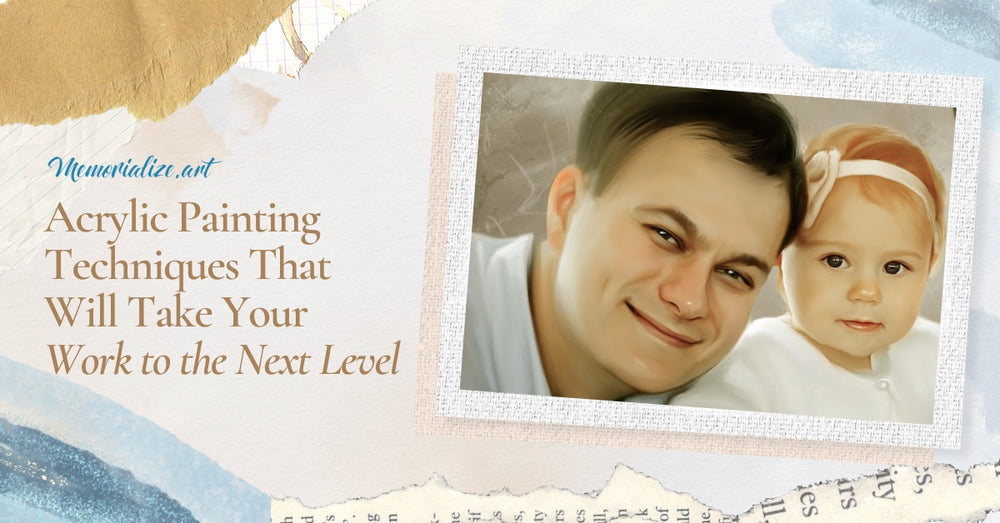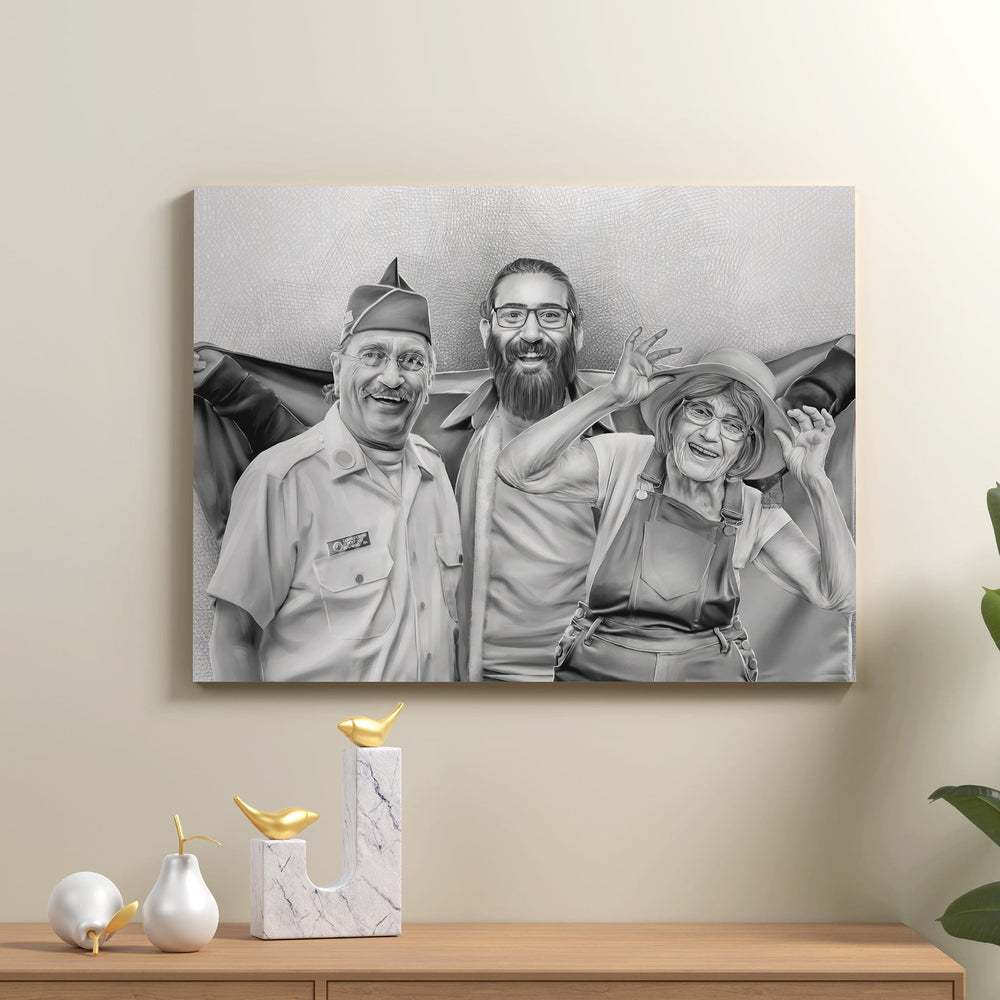7 Acrylic Painting Techniques That Will Take Your Work to the Next Level

Are you an aspiring artist looking to enhance your painting skills? Have you always admired the gorgeous couple acrylic or expressive acrylic dog painting? Are you interested in capturing the innocence and joy of a child through an acrylic baby portrait? The versatility of acrylic paints allows you to experiment with various techniques. These seven exciting acrylic painting techniques will serve as your stepping stone to a whole new world of artistry.

Photo by Jadson Thomas from Pexels
Drybrush
The drybrush technique is an excellent way to start your acrylic painting journey. This method involves applying paint directly to the canvas using a dry brush. This creates strong, confident color strokes with an uneven texture that adds a unique, tactile quality to your painting.
As you explore this technique, your brush strokes will create depth and texture, creating an expressive masterpiece. This technique is especially effective for depicting rough surfaces such as tree bark or the coarse fur of an acrylic dog painting.

Learn to Layer
Layering is a fundamental technique in acrylic painting. It involves applying multiple layers of paint, allowing each one to dry before adding the next. This method enables you to create depth, contrast, and interest in your work.
If you're painting a complex scene, such as a bustling cityscape or a detailed landscape, layering will help you build up the image and achieve a sense of realism. But remember, patience is key in this technique, as each layer needs time to dry before you proceed with the next.
Stippling
Stippling is a technique that involves creating a series of dots to form an image or texture. Using the end of your brush, you can create a dense area of small dots or vary the size and spacing to create interesting visual effects.
This technique is great for adding detail or creating an interesting textured effect. It’s an excellent choice for depicting intricate textures such as fur, grass, or the shimmering effect of light on water.
Palette Knife
Pick up your palette knife when you're in the mood to explore something different. This tool is used for mixing colors on your palette and applying paint directly onto your canvas. It creates thick, impasto-like strokes that add an element of three-dimensionality to your painting.
Whether you're creating an abstract or a realistic couple acrylic painting, the palette knife adds a bold, avant-garde touch. The beauty of this technique is that it leaves room for spontaneous gestures, allowing you to express your artistic intuition.

Get Your Custom Couple Acrylic Painting Here
Splattering and Dabbing
Splattering and dabbing are two fun and expressive techniques that allow you to add a spontaneous touch to your work. Splattering involves loading your brush with paint and flicking it onto the canvas. This creates a random pattern of paint splatters, adding an energetic, abstract element to your painting.
Dabbing, on the other hand, involves pressing your brush against the canvas, creating a textured pattern. These techniques are perfect for adding interesting accents to your artwork or creating a rich, textured background.
Glazing
While glazing isn't listed as one of the original six techniques, it’s worth mentioning. Glazing involves applying a thin, transparent layer of paint over a dried layer of color. This method allows you to alter the hue or tone of your painting without completely covering the underlying layer.
Wash

Unlike the previous two techniques that deliver bold strokes, and a wash involves thinning down your acrylic paint with water or a medium to create a transparent layer of color. Much like watercolor, a wash lets you cover a large area with a thin layer of paint, providing a softer, more ethereal quality to your piece.
An acrylic baby portrait, for example, could benefit from this technique, as it lends a soft and gentle touch to your artwork—perfect for capturing the delicate nuances of a baby's features.
Tips for Choosing the Right Techniques for Your Paintings
Choosing the right acrylic painting techniques can significantly affect how your artwork turns out. Here are some tips to guide you in selecting the best methods for your masterpiece:
Understand Your Subject Matter
The subject of your artwork often dictates the techniques you should use. For instance, dry brushing or stippling may be appropriate if you are painting a landscape with a lot of texture, such as trees or mountains.
Experiment and Practice
The best way to find out which techniques you prefer is to experiment. Try each of the techniques discussed and see what effects they produce. As you practice, you will find some techniques easier or more enjoyable than others.
Assess Your Style
Your painting style plays a significant role in choosing your techniques. If you lean towards realism, mastering layering and glazing might be beneficial. If you love abstract art, splattering, dabbing, or using a palette knife could be your go-to technique. Understanding your style will guide you in choosing the right methods.
Consider the Mood and Atmosphere
The techniques you use can greatly influence the mood and atmosphere of your painting. A wash might be your best bet if you aim for a serene and peaceful feeling. For a lively and energetic vibe, try splattering or dry brushing.
Be Patient and Persistent
Some techniques might seem challenging initially, but with patience and persistence, you'll improve over time. Don't be discouraged if you don't get it right first. Remember, art is about expression and creativity, not perfection.
FAQs
What techniques are used with acrylic paint?
Acrylic paint is versatile, allowing you to use various techniques like dry brushing, palette knife painting, washes, layering, stippling, splattering, dabbing, and glazing.
How can I improve my acrylic painting skills?
Practice and experimentation are the best way to improve your acrylic painting skills. Try different techniques, explore various subjects, and don’t be afraid to make mistakes. Joining art classes or workshops can also provide valuable insights.
How do you make fine lines with acrylic paint?
You need a fine brush and a steady hand to create fine lines. It's important to ensure that your paint consistency is right—not too thick or thin. Practicing your line work on scrap paper can also help improve your precision.
Embark on Your Artistic Journey with Memorialize Art
Now that you're armed with these acrylic painting techniques, it's time to embark on your artistic journey. Feel free to experiment, make mistakes, and, most importantly, have fun. After all, art is a celebration of creativity and self-expression.
If you'd like to enjoy the beauty of a custom abstract painting without picking up a brush, order your masterpiece at Memorialize Art. We have a team of talented artists who can bring your vision to life. Embrace the journey of self-expression with Memorialize Art as your artistic companion.










